#Josephus Flavius
Text

And the walls came tumbling...
And the walls came tumbling down -
a concise history and survey of Jericho, Qumram, Masada, Sodom and the Dead Sea region including a description of Masada
by Flavius Josephus
46 notes
·
View notes
Text
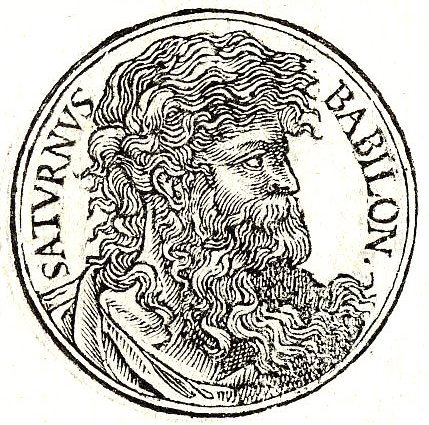
NIMROD Saturn, son of Cush, son of Ham, son of Noah, began to be strong on the earth. And the beginning of his kingdom was Babylon, Erech, Akkad, and Calneh, in the land of Shinar, in the 1788th year of the world and the 2174th year before Christ, namely that same year in which Reu was born. While he reigned a confusion of tongues was created in the building of the tower of Babel. Josephus’ Antiquities book 1, ch. 9 [sic; the quotation is actually in chapter 4] cites this saying of the Sibyl: "When all men existed with one voice, someone built a high tower, as if to ascend to the heavens by it: Truly the gods sent out winds, overthrew the tower, and individual and unique languages were distributed: therefore it came to pass that the city was called Babylon, which means “confusion”." See Genesis ch. 10 and 11 and Berossus books 4 and 5.
#nimrod#saturn#prima pars#biblical figures#mythical figures#roman myth#euhemerism#rulers#genesis#berossus#pseudo berossus#annius of viterbo#flavius josephus
8 notes
·
View notes
Text


In the name of Allah, the Beneficent, the Merciful
34:14 But when We decreed death for him, nothing showed them his death but a creature of the earth that ate away his staff. So when it fell down, the jinn saw clearly that, if they had known the unseen, they would not have remained in humiliating torment.
Josephus says: "And Solomon dies, being already aged, having reigned 80 years and having lived 94 years."
#shamir#Beast of the Earth#Solomon's Ring#maulana muhammad ali#flavius josephus#גַּם זֶה יַעֲבֹר#gam zeh yaavor
0 notes
Text
Claudius: The fool of the dynasty.
Claudius was born in Lugdunum, Gaul on August 1, 10 BC. On his mother's side, he was the grandson of the legendary Mark Antony and great-nephew of emperor Augustus. His father was the son of the Empress Livia and brother of emperor Tiberius. He also had blood ties with Julius Caesar.
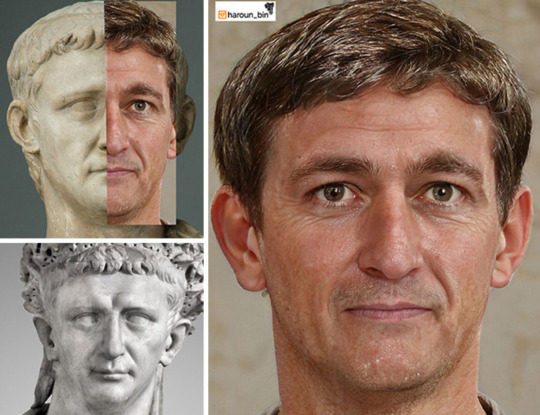
According to historical sources: His sister, Livilla, after hearing an Augur say that her younger brother would be emperor, exclaimed: "May the gods save Rome from such misfortune. That would be the end of the empire." His grandmother, Livia, avoided talking to him because "when he was a child, the empress felt uncomfortable seeing and hearing him." During his childhood, the family avoided taking him to public events so as not to be seen. All this drama just because Claudius was lame, stuttered and had a tic.
During the reigns of Augustus and Tiberius, that is, for almost his entire life, he was prohibited from holding public office because of his "defects." From a very young age it was determined that he could never be heir to the throne. This was determined by his family but not by his destiny.
Three wives, three troubles.


Year 9: The Empress Livia convinced a senator who was a close friend of her family, to marry her daughter, Plautia Urgulanilla, to her 18-year-old grandson. They had a son, Claudius Drusus, who died at 14-15 years old when he threw a piece of pear into the air to catch it in his mouth and the piece got stuck in his throat. Years before the son's death, a girl was born. But months later, Claudius noticed that the baby looked more like one of his freedmen than him. Claudius publicly declared that the girl was not his daughter. This scandal occurred at the same time that her brother-in-law, Plautia's brother, murdered her wife by throwing her out of a window. After this, Claudius immediately divorced.
Year 28: The prefect of the Praetorian Guard, Sejanus, was plotting to occupy the throne. Knowing that no one would accept an emperor who was not related to the dynasty, he married his sister, Elia Paetina, to Claudius. They had a daughter named Antonia. In the year 31 the plots and murders of Sejanus were discovered; Emperor Tiberius sentenced him to death. Claudius was forced to divorce the relative of the traitor but he never abandoned his daughter Antonia.
Year 38: During the reign of his nephew Caligula, Claudius married a woman member of the dynasty. The young and beautiful Valeria Messalina was the granddaughter of Antonia the Elder, Claudius's aunt. Antonia the Elder was the first daughter that Mark Antony had with Augustus's sister. Ten years later, this third marriage will end in worse circumstances than the first two.
Interestingly, "the mad emperor Caligula" was the first of that family to see that nothing prevents Claudius from holding an important position. Claudius at age of 46 was appointed consul.
The less thought day
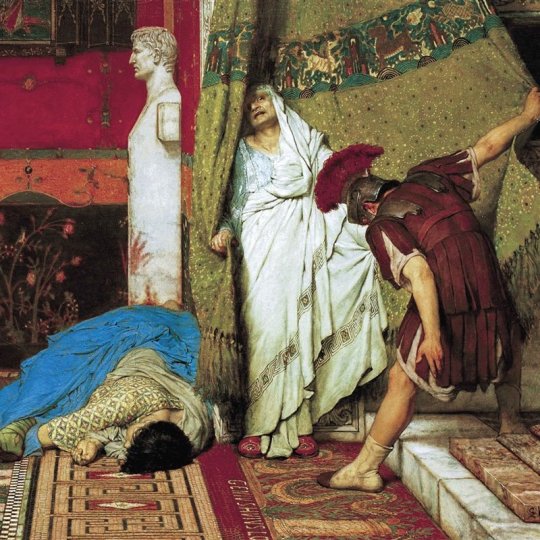
On January 24, 41, the emperor was assassinated by the Praetorian Guard in collusion with several senators. Minutes later, the emperor's wife and daughter were also murdered.
And what no one would have thought possible happened: At the age of 50 Claudius became Caesar. The fourth emperor of Rome.
According to the historians Flavius Josephus and Cassius Dion, Claudius, terrified, thinking that the senators' plan was to exterminate all the members of the imperial family to restore the republic, hid behind a curtain. A Praetorian soldier found him and immediately proclaimed him emperor because he was the only male in the dynasty who could rule, the other remaining member being his 3-year-old grandnephew Lucio Domitius, whom 9 years later Claudio himself would give the famous name Nero.
Claudius the Conquer

Claudius surprised Rome by proving to be not only an intelligent emperor but also a conqueror who would make the empire greater. In 43, Claudius begins the campaign to conquer Britannia. Circa 50 the Romans founded the city Londinium /London.
Although this was his most famous conquest and territorial expansion, it was not the only one. Noricum: Present-day central Austria (west of Vienna), part of Bavaria (Germany), northeastern Slovenia, and part of the Italian Alps. Thrace (Bulgaria), and he made the Danube River a new border of the Roman Empire.
Claudius the Emperor
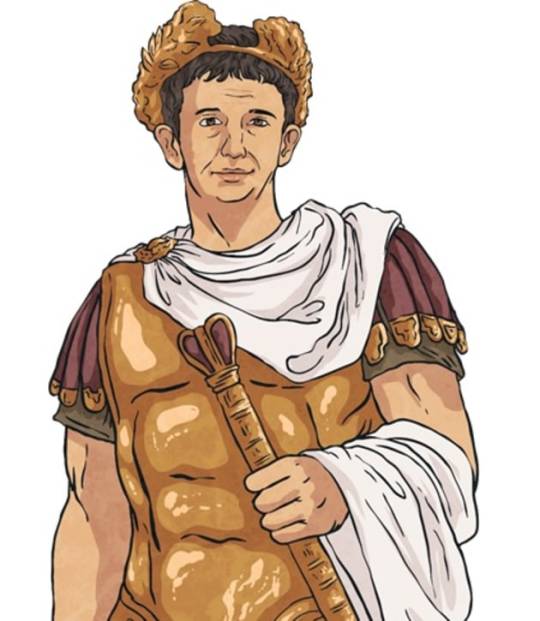
He distinguished himself for his policy of Meritocracy. He rewarded for ability , not for personal sympathies. He allowed men from of non-aristocratic origin access to the Senate. Claudius gained the respect of the Senate, the army and the people at the same time, something that had not been seen in Rome since the time of Augustus.
He had two children with his third wife: Octavia, born late year 39, and Tiberius Claudius, later nicknamed Britanicus due the conquest of Britannia, born 19 days after Claudius' accession to the throne.
He wrote many works, most during the reign of Tiberius. In addition to a history of the reign of Augustus and some treatises on the game of dice, his great passion, among his main works are a History of Etruscan civilization in twenty books, a History of Carthage in eight volumes, and a dictionary of the Etruscan language.
Pliny the Elder refers to Claudius as "One of the best writers". Evidently, Claudius learned a lot from his teacher, the most prestigious Roman historian, Titus Livius (Livy), author of the extraordinary work Ab Urbe Condita.
In the year 47 Claudius celebrated the Ludi Saeculares of the eighth centenary of the founding of Rome.
The tragic end of the empress.

Empress Valeria Messalina becomes the lover of Senator Gaius Silius. Taking advantage of her lineage as a woman of the Julio-Claudian dynasty, she convinced that man that together they could take the throne from Claudius. In 48, while Claudius was in Ostia, Messalina divorced him and married Silius. Three freedmen arrived in Ostia to give the incredible news to the emperor.
According to Tacitus: "Claudius, having returned to the palace, ordered that Messalina be brought to him, but the freedman Narcissus, fearing that the emperor would forgive her, ordered a freedman, a centurion, and some tribunes to proceed with the execution. The woman was overtaken in the gardens and executed; informed of his wife's death while he was at the table, Claudio would not have asked any more questions."
The senator and his group of accomplices and supporters were also executed.
Seven years earlier: Claudius ordered the return of his nieces, daughters of his deceased brother Germanicus:, Livilla and Agrippina the Younger, both exiled by Caligula in 39. Livilla was highly favored by Claudius, and Agrippina the Younger was beloved by the people. This situation caused Messalina worry and jealousy.
Messalina, through intrigue, in a very short time managed to send Livilla back into exile, along with the philosopher Seneca -a close friend and ally of Agrippina the Younger- accusing them of being lovers and conspiring. Livilla died in exile shortly after arriving.
Livilla was just one of the first victims of Messalina's intrigues; The list is very long. The only really bad thing I found in Claudius was allowing himself to be easily manipulated and convinced by Messalina and committing many injustices because of her.
But Mesalina could not make Agrippina the Younger disappear, who was extremely cunning and more dangerous than Livilla because she had a son, that is, a candidate for the throne who, to make matters worse, he had more blue blood than Britannicus. In all likelihood, this could be the reason Messalina attempted to overthrow Claudius.
The fourth wife, and the death.

If Senator Gaius Silius was able to use Messalina's lineage to try to overthrow Claudius by marrying her, what could another do who marries the widow Agrippina, a direct descendant of Divine Augustus? This was the reason for Claudio's incredible decision to marry his niece: simply so that no other man could marry her. Agrippina immediately accepted the proposal to become empress of Rome.
The marriage between an uncle and his niece was considered incest and a crime in Rome. However, this was not an incestuous relationship but a political union. Even so, dispensations had to be presented to the Senate and religious authorities, and there were endless ceremonies.
Finally, in the year 49, in an unprecedented event in Roman history, the Emperor married his own niece. Immediately Agrippina gets Claudius to bring her close friend Seneca from exile, and orders the remains of her exiled sister to be brought to be cremated in an honorable funeral and the urn placed in the mausoleum of Augustus. Agrippina appoints Seneca as her son's tutor and teacher. Claudius granted Agrippina the title of Augusta. Curiously, when Claudius ascended the throne he did not grant that title to his wife Messalina but to his deceased mother Antonia the Younger.
In 50 Claudius adopted his great-nephew Lucius as son and changed his name to Nero Claudius. Agrippina's son become the heir to the throne, instead Emperor's own son. Many historians believe that this was because in the Dynasty, when choosing the successor it was more important to take into account who he was descended from in a direct line. Nero, unlike Britannicus, was a direct descendant of Augustus (great-great-grandson).
Later, Agrippina convinces Claudius to marry his daughter Octavia to Nero. At that time Nero and Octavia are around 14 and 12 years old respectively.
In October 13 of 54, at age 64, the emperor died suddenly during a banquet, after having eaten poisoned mushrooms, according to Juvenal's version.
There are several versions about his death, however they all agree on the theory that the emperor was poisoned. Personally, I want to believe that his death was due to natural causes. The life story of this emperor is extraordinary, it does not deserve such a poor ending.
Below, a text that is not mine but from a very important site with an extensive article on Emperor Claudius. I copy and paste the final part that I was happy to read.

However, as Levick points out, those present at the banquet do not seem to have suspected poisoning of any sort; moreover, the eunuch Halotus, whose job was to taste the Emperor's food, kept his job when Nero assumed the throne—evidence that nobody wanted to put him out of the way, either as an accomplice or as a witness to assassination.
We see no reason to believe that Claudius was murdered. All the features are consistent with sudden death from cerebrovascular disease, which was common in Roman times. Towards the end of 52 AD, at the age of 62, Claudius had a serious illness and spoke of approaching death. Around that time there were changes in his depiction in busts, cameos and coins—with thick neck, narrow shoulders and flat chest. The Apocolocyntosis, addressed to an audience some of whom were present at the death, makes clear that there is no need to postulate poisoning, accidental or otherwise.
Text : © 2002, The Royal Society of Medicine.
The Divine Claudius

Sculpture of Claudius deified (1st Century) Vatican Museums.
After his death, like Augustus, he was deified.
The boy who everyone said could never achieve anything became a great writer, emperor, conqueror and a god.
168 notes
·
View notes
Text
by Sophie Kalmin
The Roman period left various indelible marks on the Jewish psyche, further exhibited by the remains of the Masada fortress. Excavated in the 1960s, King Herod’s first-century BCE stronghold serves as a powerful symbol of Jewish resilience. It was at Masada that Jewish rebels stood firmly against the Romans before the fortress was destroyed, and the Romans marked another victory over the land’s people. Today, Masada serves as one of the most popular tourist sites in Israel, in which visitors can interact with ancient cisterns, pottery, and engineering feats completed by Jewish architects. With areas of the fortress still yearning to be excavated, Masada prevails as one of the most poignant reminders of the Jewish connection to the Land of Israel — Jewish people died defending it thousands of years ago.

Historians say…
Beyond archaeology, the writings of Flavius Josephus, a first-century Jewish historian, provide an insider experience of Jewish life and Roman governance in Judea. In his work Antiquities of the Jews, Josephus details the Roman administrative presence in the region, including the taxation policies implemented by the governor of Syria, Cyrenius. Flavius notes, “Moreover Cyrenius came himself into Judea, which was now added to the province of Syria, to take an account of their substance, and to dispose of Archelaus’s money.” This account emphasizes both Jewish property and economic activities in Roman Judea. Josephus’s comprehensive records serve as a critical source, underscoring the continuous Jewish involvement in this land across millennia.
Benjamin Tudela, the 12th-century author of The Itinerary of Benjamin of Tudela, records Jewish activity at the Cave of Machpelah. Tudela, a Jew living in the Middle Ages, describes the religious practices being exercised distinctly at this place. He writes that casks of generations of Israelites are buried within the cave and that our forefathers constructed “a gate of iron” to protect those visiting their loved ones’ remains. Because of Tudela, the stories of connection between Jewish people and their ancestors buried in the Land of Israel resonate more deeply.
Lasting Jewish Practice
The discovery of the Dead Sea Scrolls in the early 20th century provides arguably the most compelling evidence of the Jewish people’s enduring connection to their land and heritage. These ancient manuscripts, which date back to the last three centuries BCE and the first century CE, include the earliest known copies of the Hebrew Bible, providing invaluable insights into Jewish life, law, and beliefs during the Second Temple period. Written in Hebrew, Aramaic, and Greek, these scrolls are a powerful symbol of Jewish spiritual and intellectual resilience. Their survival over two millennia affirms the enduring legacy of Jewish scholarship and the community’s unwavering commitment to preserving their sacred texts.

Israel is the Jewish Homeland
When British ships landed in North America in the late 16th century, they didn’t dig up Shakespeare plays and find ancient coins minted in English. By definition, colonial powers are not indigenous to the places they colonize. Jews have maintained a continuous presence in Israel since Judaism’s inception, despite numerous conquerors that have come along and expelled the Jews from their land. These exiles are not only thoroughly documented in Jewish literature and cultural evolution, but in continuous archaeological findings. Failed attempts to eradicate the Jewish people from their land have reinforced the urgency of the lasting existence of a Jewish country.
50 notes
·
View notes
Photo

The Bar-Kochba Revolt
The Bar Kochba Revolt (132–136 CE) was the third and final war between the Jewish people and the Roman Empire. It followed a long period of tension and violence, marked by the first Jewish uprising of 66-70 CE, which ended with the destruction of the Second Temple, and the Kitos War (115-117 CE). In many ways, the Bar Kochba Revolt differed markedly from its predecessors. For the first time, the Jews presented a united front against Roman forces and fought underneath a single charismatic leader, the eponymous Simon Bar Kochba (also given as Shimon Bar-Cochba, Bar Kokhba, Ben-Cozba, Cosiba or Coziba). It was marked as well by strong religious passions, with many apparently believing that Bar Kochba was the promised messiah who would lead the Jewish people to final victory against their enemies.
In its initial stages, the revolt was surprisingly successful and may have resulted in the destruction of an entire Roman legion. It is possible that the rebels regained control of the city of Jerusalem, and they must have held large portions of ancient Judea. The Romans, however, regrouped and adopted a scorched-earth strategy that ultimately extirpated the rebels and laid waste to the country. The war shattered Judean society and led to far-reaching demographic and political changes, with the majority of the Jewish population of the province killed, enslaved, or exiled, and their national hopes definitively crushed. The Jewish people would not regain their political independence until the Zionist era and the establishment of the State of Israel in 1948 CE.
The Problem of Sources
Unlike the revolt of 66 CE, the historical sources on the Bar Kochba Revolt are scanty at best. The war had no chronicler such as Josephus Flavius, at least none whose work has survived. The primary non-Jewish sources are an epitome of Cassius Dio's Roman History and a handful of lines by the ecclesiastical historian Eusebius, the bishop of Caesarea. The war is also briefly mentioned by the Church father Jerome. While by no means comprehensive, these sources do provide several important details.
The Jewish sources are not per se historical and, while also scanty, are found throughout the rabbinical literature of the period and after, in particular, in the Jerusalem and Babylonian Talmuds. While they are often clearly legendary and unreliable in nature, they do paint a general picture of the Jewish experience of the war and its aftermath.
In addition, several important archaeological finds have shed light on certain aspects of the revolt. Coins minted while Judea was temporarily freed from Roman rule indicate the existence of an independent Jewish state for a brief period. In the 1960s CE, a cave in the Judean desert was found that likely once housed refugees from the revolt. Called the “Cave of Letters,” it contained a cache of documents that included several letters from Bar Kochba himself, which shed unprecedented light on his personality and style of rule.
Continue reading...
53 notes
·
View notes
Text
The Antonian Reading List
Mark Antony: A Life by Patricia Southern (Highly recommended!)
Mark Antony: A Biography by Eleanor Goltz Huzar (Highly recommended!)
The Life and Times of Marc Antony by Arthur Weigall (Recommended)
Marc Antony: His Life and Times by Allan Roberts (Recommended)
Marc Antony by Mary Kittredge
Antony & Cleopatra by Patricia Southern
Antony & Cleopatra by Adrian Goldsworthy (By far the most negative book on Antony by a modern historian, the Cleopatra portion is better)
Mark Antony: A Plain Blunt Man by Paolo de Ruggiero (Recommended)
Mark Antony and Popular Culture: Masculinity and the Construction of an Icon by Rachael Kelly
Mark Antony's Heroes: How the Third Gallica Legion Saved an Apostle and Created an Emperor by Stephen Dando-Collins
A Noble Ruin: Mark Antony, Civil War and the Collapse of the Roman Republic by W. Jeffrey Tatum (Highly recommend!)
Mark Antony & Cleopatra: Cleopatra's Proxy War to Conquer Rome & Restore the Empire of the Greeks by Martin Armstrong
Actium and Augustus: The Politics and Emotions of Civil War by Robert Alan Gurval
The Roman Revolution by Ronald Syme (Recommended)
Octavian, Antony and Cleopatra by W. W. Tarn
Fulvia: Playing for Power at the End of the Roman Republic by Celia E. Schultz
Cleopatra: Last Queen of Egypt by Joyce Tyldesley (Highly Recommended!)
Cleopatra by Michael Grant (Highly Recommanded!)
Cleopatra: A Life by Stacy Schiff (Highly Recommended!)
Cleopatra - A Biography by D. Roller
Cleopatra and Antony by Diana Preston
Cleopatra by Alberto Angela (Recommended)
Cleopatra by Jacob Abbott
Cleopatra the Great by Joann Fletcher
Cleopatra and Egypt by Sally-Ann Ashton
Cleopatra and Rome by Diana E. E. Kleiner
Cleopatra Her History Her Myth by Francine Prose
Cleopatra Histories, Dreams, and Distortions by Lucy Hughes Hallett (Recommended)
Cleopatra’s Daughter Egyptian Princess by Jane Draycott
The Storm Before the Storm by Mike Duncan
SPQR: A History of Ancient Rome by Mary Beard (Good for beginners)
The Last Assassin: The Hunt for the Killers of Julius Caesar by Peter Stothard
Robicon by Tom Holland
Alesia 52 BC: The final struggle for Gaul (Campaign) by Nic Fields
Actium 31 BC: Downfall of Antony and Cleopatra (Campaign) by Si Sheppard
Pharsalus 48 BC: Caesar and Pompey – Clash of the Titans (Campaign) by Si Sheppard
Philippi 42 BC: The death of the Roman Republic (Campaign) by Si Sheppard
Mutina 43 BC: Mark Antony's struggle for survival (Campaign) by Nic Fields
The War That Made the Roman Empire: Antony, Cleopatra, and Octavian at Actium by Barry Strauss
The Battle of Actium 31 BC: War for the World by Lee Fratantuono
Rome and Parthia: Empires at War: Ventidius, Antony and the Second Romano-Parthian War, 40–20 BC by Gareth C Sampson
Rivalling Rome: Parthian Coins and Culture by Vesta Curtis
Classical sources:
Plutarch’s Lives
Cicero: Philippics, Ad Brutum, Ad Familiares
Appian, The Civil Wars
Dio Cassius, The Roman History
Suetonius, The Twelve Caesars
Flavius Josephus, The Jewish War
Livy, The Early History of Rome
Tacitus, Annals and Histories
Friction:
The Tragedy of Julius Caesar by William Shakespeare
The Tragedy of Antony and Cleopatra by Willian Shakespeare
All For Love or The World Well Lost by John Dryden
The Siren and the Roman – A Tragedy by Lucyl
Caesar and Cleopatra by George Berbard Shaw
Cleopatra (play) by Sardou
Antony by Allan Massie
I, Claudius by Robert Graves
I, Cleopatra by William Bostock
Cleopatra by H. Rider Haggard
Cleopatra by Georg Ebers
Kleopatra (Vol I & II) by Karen Essex
Last Days with Cleopatra by Jack Lindsay
The Memoirs of Cleopatra by Margaret George
When We Were Gods by Colin Falconer
The Masters of Rome series by Colleen McCullough
Caesar's Soldier: Mark Antony Book I by Alex Gough (Ongoing series)
The Antonius Trilogy by Brook Allen
The Last Pharaoh series by Jay Penner
Throne of Isis by Juith Tarr
Hand of Isis by Jo Graham
Woman of Egypt by Kevin Methews
The Ides of Blood 01-06 (Comics)
Terror - Antonius En Cleopatra (Erotic yet pure love, Dutch comics)
Cleopatra - Geschiedenisstrip (Dutch comics)
Les Grands Personnages de l Histoire en Bandes Dessinees – Marc Antonie (French comics)
Les Grands Personnages de l Histoire en Bandes Dessinees – Cleopatre (French comics)
Les Grands Personnages de l Histoire en Bandes Dessinees – Julius Caesar (French comics)
Cléopâtre (French Manga)
Ils Ont Fait L'histoire - Cléopâtre (French Graphic Novel)
#mark antony#marc antony#marcus antonius#cleopatra#cleopatra vii#antony and cleopatra#rome#ancient rome#roman history#roman republic#roman empire#books#book recommendations#reading list#to read list#history
92 notes
·
View notes
Text
me: supposed to work on a commentary of mf flavius josephus' the jewish war
also me: haha nooo alastor is sooo hot here have a sneak peak on what i'm working on
you startle.
he’s sitting in front of you, glass full of rye, eyes mellowing out at your sight. you think you hear him chuckle, the sound warm and deep and rich. you cross your leg over the other to quell the burning heat in you and muster up a smile.
“alastor. pleasure to see you.”
“the pleasure’s all mine, cher.”
his lips are on you again, burning hot against your hand. you think he’ll devour you whole, with the way he looks at you through hooded eyes, with the way you can feel the press of his teeth behind his lips.
#alastor x reader#obticeo writes#hazbin hotel#hazbin hotel x reader#alastor the radio demon#alastor the radio demon x reader#i will finish this wip#i swear it#human alastor x reader#human alastor#wip. you twist i turn/who's the first to burn?
54 notes
·
View notes
Note
Do you remember how you asked about the evidence for the existence of Jesus
I was lookin a bit
Overall, there is no hard evidence that Jesus existed. There are, however, references to the fact that crucifixions actually took place in his time, which is not too surprising but worth noting since we are talking about religion. Flavius Josephus also wrote about Jesus Christ as a person who lived at almost the same time as him. Josephus was born shortly after the alleged crucifixion of Jesus. He didn't know him personally, but apparently he knew people who talked and heard about Jesus. So there are non-Christian sources talking about Jesus, but they are mainly writings, so they have as much credibility as the Bible (imo).
I swear I looked for evidence but couldn't find anything except this, which is extremely irritating. I will keep looking, but that's all for now 😩
(._. )
I appreciate the info! This matches up with my half-remembered thoughts about the matter.
I'm a non-practicing Catholic myself, so for me Jesus and the stories about him are just kind of a cultural backdrop.
What drives your interest in him?
5 notes
·
View notes
Text
“Lényegében nincs komoly történész, aki Jézust a bibliai formában (eltekintve még a feltámadástól is) történelmi személynek tekintené. A humanista szövegkritika megjelenése óta ismeretes, hogy a Jézus létezését úgymond "bizonyító" Josephus Flavius-szövegrész (a Testimonium Flavianum) késői betoldás, ezt már a katolikus egyház sem tagadja.
Hogy élt-e a történeti, hús-vér Jézus, valójában másodrendű kérdés mind az ateisták, mind a hívők számára. A kereszténység gyakorlata, ideológiája, teológiája így is, úgy is kiválóan eljár tengelyén. A témával foglalkozó kutatók egy jókora része inkább arra hajlik, hogy több figurából, létező személyekből és mítoszokból összegyúrt kultúrhérosznak tekintsék Jézust, így történetiségét megkérdőjelezve elismerjék a Jézus-jelenség konkrét történeti szerepét. Ebben nem egy reformteológus is egyetért velük. Jézus a nyugati világ egyik legátfogóbb metaforája.
A politikai kereszténység egyszerűsített, lebutított kvázivallási üzenetei persze nem ismernek el ilyen kihágásokat. Az új NER-magyar, hivatalosan központi, kötelezően önkéntes "tankönyvek" egyszerű kijelentőmódban írnak Jézus életéről, a szeplőtelen fogantatásról, sőt a feltámadásról és a mennybemenetelről is - amiben természetesen már nyoma sincs semmiféle feltételezhető tudományos (vagy akár teológiai) konszenzusnak.”
- Konok Péter, Fb komment
34 notes
·
View notes
Photo

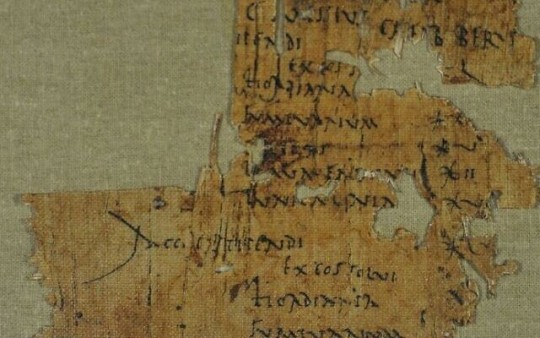

Roman Soldier’s 1,900-Year-Old Pay-Slip Uncovered in Masada
During excavations at Masada, archaeologists from the Israel Antiquities (IAA) uncovered a papyrus payslip dated to 72 BC belonging to a Roman soldier.
Masada is a rugged crag in the Judean Desert overlooking the Dead Sea. Herod, the first-century BCE Judean king best known for constructing Jerusalem’s Temple Mount complex, built a fortress and palace on the mountain.
Jewish rebels entrenched themselves at Masada a century later, from 66 to 74 CE, during the Jewish Revolt against Rome. A Roman army besieged the last holdouts nearly four years after the fall of Jerusalem.
The only historical account of the conflict is Josephus Flavius, who claims that the Jewish rebels all committed mass suicide before Roman troops stormed the battlements. However, archaeologists dispute that account’s historical accuracy.
The IAA discovered a detailed military paycheck (one of only three legionary paychecks discovered throughout the Roman Empire) issued to a Roman legionary soldier during the First Jewish-Roman War in AD 72. The paycheck is one of 14 Latin scrolls found at Masada by archaeologists – 13 of which was written on papyrus, and one on parchment paper.
Although the papyrus was damaged over time and therefore very fragmentary, it contains valuable information about the management of the Roman army and the status of the soldiers. The document provides a detailed summary of a Roman soldier’s salary over two pay periods (out of three he would receive annually), including the various deductions that he was charged. The army supplied the soldiers with basic equipment, but, as today, some soldiers chose to add and upgrade their equipment.
“This soldier’s paycheck included deductions for boots and a linen tunic, and even for barley fodder for his horse,” says Dr. Oren Ableman, senior curator-researcher at the Israel Antiquities Authority Dead Sea Scrolls Unit.
“Surprisingly, the details indicate that the deductions almost exceeded the soldier’s salary. Whilst this document provides only a glimpse into a single soldier’s expenses in a specific year, it is clear that in the light of the nature and risks of the job, the soldiers did not stay in the army only for the salary.
According to Dr. Ableman, “The soldiers may have been allowed to loot on military campaigns. Other possible suggestions arise from reviewing the different historical texts preserved in the Israel Antiquities Authority Dead Sea Scrolls Laboratory.
For example, a document discovered in the Cave of Letters in Nahal Hever from the time of the Bar Kokhba Revolt (132–135 CE) sheds some light on some side hustles Roman soldiers used to earn extra cash. This document is a loan deed signed between a Roman soldier and a Jewish resident, the soldier charging the resident with interest higher than was legal. This document reinforces the understanding that the Roman soldiers’ salaries may have been augmented by additional sources of income, making service in the Roman army far more lucrative.”
By Leman Altuntaş.
#Roman Soldier’s 1900-Year-Old Pay-Slip Uncovered in Masada#archeology#archeolgst#ancient artifacts#history#history news#ancient history#ancient culture#ancient civilizations#roman history#roman empire#first jewish-roman war#king herod
74 notes
·
View notes
Text

OTHNIEL, son of Kenaz and younger brother of Caleb, of the tribe of Judah, was Judge of the people of Israel in the 2538th year of the world and the 1424th year before Christ was born.
The spirit of the Lord was in him, and he went out to battle, and the Lord delivered King Cushan-rishathaim of Syria, who the Israelites had served for eight years, into his hands, and he killed him. He was Judge of Israel for forty years, and he died. Judges 3; Josephus Antiquities book 5 ch. 8.
6 notes
·
View notes
Note
So re your tags on the pope post...
Where's the menorah krindor?
So, starting at the very beginning.
70 CE: Titus sacks Jerusalem and loots the Second Temple. In his triumph (fancy war parade) he has the Menorah, as is recorded by Josephus Flavius in 71 CE and by the Arch of Titus' reliefs in 81 CE
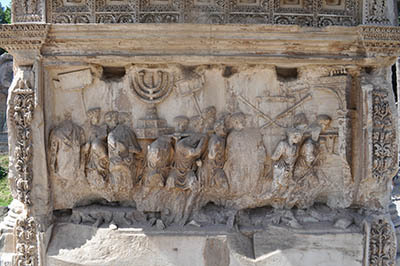
The Menorah is displayed in the Tempulum Pacis in Rome, and 2nd century CE Rabbis claim to have seen it in Rome, as well as various other artifacts from the desroyed temple including the parochet and the choshen.
Now here's the thing. This is the last time historical texts mention the Menorah by name so everything below here needs to be taken with an increasing pile of salt
410 CE: The Visigoths sack Rome. Procipius of Ceasarea (500-560), a Byzantine Historian, writes that the Visigoths take "treasures of Solomon the King of the Hebrews." If this includes the Menorah, the trail goes cold. So that's it right? The Menorah got taken to a secondary location and was lost forever, right?
Wrong, because that's not the only time Procipius mentions Jewish Temple loot.
425 CE: The Vandals sack Rome again, to the point where the word vandalize comes from it. Procipius notes that their leader, Geiseric, takes "a huge amount of imperial treasure" with him to Carthage, which was at that time the Vandal capital.
Trust me this is relevant
534 CE: The Byzantine Emperor Justinian sacks Carthage, and they hold a triumph in Constantinople. Among the paraded items are "treasures of the Jews, which Titus, the son of Vespasian, together with certain others, had brought to Rome after the capture of Jerusalem”
That these "treasures of the Jews" include the Menorah is not a new theory, as is indicated in the 19th century painting Geiseric sacking Rome by Karl Bryullov

(Note the Menorah)
So it's in Istanbul right?
Wrong, because our boy Procipius isn't done yet: according to him, Justinian sent the "treasures of the Jews" to Christian sanctuaries in Jerusalem, since he heard that they were cursed that any city save Jerusalem that held them was doomed to be sacked.
This is the last time the "treasures of the Jews" are mentioned in historical texts.
So for our next step, lets look at major churches in Jerusalem in the 6th century, and officially enter the cork-board and string section of this rant post.
As well as the extant Church of the Holy Sepulcher, the Hagia Sion Basilica, and the Church of the Holy Apostles, Justinian built a church himself in the city, called the Nea, in 534 CE, just nine years after sacking Carthage. It would not be unreasonable that he'd send the Menorah to his own church, so we can theorize that it's in the Nea for the remainder of the 6th century (there are, of course, problems with relying on one historian's account of these things, but this is for fun, not a published article)
So that's it? It's in one of the churches of Jerusalem?
...
So in 614 CE Jerusalem gets sacked by the Sasanian/Persian Empire, who according to historical records destroy all the churches.
Now here's the thing. Recent archaeological evidence gives rise to the possibility that our Byzantine historical sources are trying to stir up outrage against the Sasanians: While mass graves dating to around 614 CE were found, the churches and Christian residential neighborhoods were barely, if at all, damaged, and the Nea itself was very possibly completely undamaged. This is, however, a recent theory, and the academics are still hashing it out.
So it may be in one of the churches of Jerusalem?
Tragically, even if the 614 siege didn't get the churches, in 1009 the Fatimid Caliph al-Hakim bi-Amr Allah destroyed all churches, synagogues, and many religious artifacts of both Christians and Jews in Jerusalem. So if by some miracle the Menorah had survived until this point, if it was in Jerusalem it was most likely destroyed.
But that's disappointing, and what's a good conspiracy theory without going a step or two beyond what is reasonable?
Apparently, while the churches, synagogues and most of the artifacts were destroyed, at least in the case of the Church of the Holy Sepulcher, objects that could be carried away were looted, rather than destroyed. And if we know anything about the Menorah at this point, that thing is certainly able to be carried away by people.
If the Menorah was looted rather than destroyed, it's not unreasonable that it would have made it's way to the Fatimid capital of Cairo. However, as the historical record dried up some 500 years beforehand, beyond this point it's unreasonable to attempt to track the Menorah.
So that's it. If the Menorah wasn't destroyed it most likely made its way to Egypt and was lost or destroyed there.
Is what I'd say if I wasn't so far down this rabbit hole I was beyond reason. Because as we all know there's one place that has all the significant treasures of Cairo and a penchant for looting:
The British Museum
#i cant in good conscience call this either archaeology or history#anyway this is very unhinged but was fun to research#pseudoarchaeology#pseudohistory#jewish stuff
14 notes
·
View notes
Text
Non-Christian sources confirm the validity of New Testament
The Jewish historian, Flavius Josephus (A.D. 37-100), is the first non-Christian author to mention Jesus. In the Antiquities, Josephus writes:
There was about this time Jesus, a wise man, if it be lawful to call him a man, for he was a doer of wonderful works—a teacher of such men as receive the truth with pleasure. He drew over to him both many of the Jews, and many of the Gentiles. He was Christ; and when Pilate, at the suggestion of the principal men amongst us, had condemned him to the cross, those that loved him at the first did not forsake him, for he appeared to them alive again the third day, as the divine prophets had foretold these and ten thousand other wonderful things concerning him; and the tribe of Christians, so named from him, are not extinct at this day (Antiquities 18:3:3).
Tacitus (A.D. 56-120), the Roman historian confirms that the crucifixion of Jesus actually took place. Writing in his Annals, he records:
Consequently, to get rid of the report, Nero fastened the guilt and inflicted the most exquisite tortures on a class hated for their abominations, called Christians by the populace. Christus, from whom the name had its origin, suffered the extreme penalty during the reign of Tiberius at the hands of one of our procurators, Pontius Pilatus, and a most mischievous superstition, thus checked for the moment, again broke out not only in Judæa, the first source of the evil, but even in Rome, where all things hideous and shameful from every part of the world find their centre and become popular. Accordingly, an arrest was first made of all who pleaded guilty; then, upon their information, an immense multitude was convicted, not so much of the crime of firing the city, as of hatred against mankind.
Pliny the Younger (A.D. 62-113), Roman governor in Asia Minor, established that early Christians worshiped Jesus as a god:
They (Christians) were in the habit of meeting on a certain fixed day before it was light, when they sang in alternate verses a hymn to Christ, as to a god, and bound themselves by a solemn oath, not to any wicked deeds, but never to commit any fraud, theft or adultery, never to falsify their word, nor deny a trust when they should be called upon to deliver it up; after which it was their custom to separate, and then reassemble to partake of food, but of an ordinary and innocent kind (Epistles 10.96).
Suetonius (120 AD) was a Roman historian and court official. When recounting the history of the emperor Claudius some years before him, he said,
“Because the Jews at Rome caused constant disturbances at the instigation of Chrestus [Christ], he [Claudius] expelled them from the city [Rome]” (Life of Claudius, 25:4).
Lucian, born (c. AD 125 – 180), the pagan author Samosata, while ridiculing Christians, accepted that Jesus actually existed:
The Christians, you know, worship a man to this day—the distinguished personage who introduced their novel rites, and was crucified on that account. … You see, these misguided creatures start with the general conviction that they are immortal for all time, which explains their contempt of death and voluntary self-devotion which are so common among them; and then it was impressed on them by their original lawgiver that they are all brothers, from the moment that they are converted, and deny the gods of Greece, and worship the crucified sage, and live after his laws. All this they take quite on faith, with the result that they despise all worldly goods alike, regarding them merely as common property. (Lucian, The Passing of Peregrinus)
Celsus (2nd century), the Greek philosopher, while arguing against Christianity, also accepted that Jesus existed:
O light and truth! He distinctly declares, with his own voice, as ye yourselves have recorded, that there will come to you even others, employing miracles of a similar kind, who are wicked men, and sorcerers; and Satan. So that Jesus himself does not deny that these works at least are not at all divine, but are the acts of wicked men; and being compelled by the force of truth, he at the same time not only laid open the doings of others, but convicted himself of the same acts. Is it not, then, a miserable inference, to conclude from the same works that the one is God and the other sorcerers? Why ought the others, because of these acts, to be accounted wicked rather than this man, seeing they have him as their witness against himself? For he has himself acknowledged that these are not the works of a divine nature, but the inventions of certain deceivers, and of thoroughly wicked men.
~ Samples, Kenneth Richard. ‘Without a Doubt: Answering the 20 Toughest Faith Questions
11 notes
·
View notes
Text

The Holy Innocents are the children mentioned in the gospel of Matthew, Chapter 2:16-18.
Herod, perceiving that he was deluded by the wise men, was exceedingly angry.
He sent his soldiers to kill all male children ages two and under that were in Bethlehem and on the boarders, according to the time which he had diligently inquired of the wise men.
Then the prophesy of Jeremiah was fulfilled:
"A voice in Rama was heard, of lamentation and great mourning; Rachel bewailed her children and would not be comforted, because they were not."
The Greek Liturgy asserts that Herod killed 14,000 boys, the Syrians speak of 64,000, and many medieval authors speak of 144,000, according to Rev. 14:3.
Modern writers reduce the number considerably, since Bethlehem was a rather small town.
Knabenbauer brings it down to fifteen or twenty (Evang. S. Matt., I, 104), Bisping to ten or twelve (Evang. S. Matt.), and Kellner to about six (Christus and seine Apostel, Freiburg, 1908).
This cruel deed of Herod is not mentioned by the Jewish historian Flavius Josephus, although he relates quite a number of atrocities committed by the king during the last years of his reign.
The number of these children was so small that this crime appeared insignificant amongst the other misdeeds of Herod.
Macrobius relates that when Augustus heard that amongst the boys of two years and under, Herod's own son also had been massacred, he said:
"It is better to be Herod's hog than his son," alluding to the Jewish law of not eating, and consequently, not killing swine.
The Middle Ages gave faith to this story, and Abelard inserted it in his hymn for the feast of Holy Innocents.
It is impossible to determine the day or the year of the death of the Holy Innocents, since the chronology of the birth of Christ and the subsequent Biblical events is most uncertain.
All we know is that the infants were slaughtered within two years following the apparition of the star to the Wise Men (Belser, in the Tubingen "Quartalschrift," 1890, p. 361).
The Church venerates these children as martyrs (flores martyrum); they are the first buds of the Church killed by the frost of persecution; they died not only for Christ, but in his stead (St. Aug., "Sermo 10us de sanctis").
The Latin Church instituted the feast of the Holy Innocents at a date now unknown, not before the end of the fourth, and not later than the end of the fifth century.
The Roman Station of December 28 is at St. Paul's Outside the Walls, because that church is believed to possess the bodies of several of the Holy Innocents.
A portion of these relics was transferred by Sixtus V to Santa Maria Maggiore.
The church of St. Justina at Padua, the cathedrals of Lisbon and Milan, and other churches also preserve bodies, which they claim to be those of some of the Holy Innocents.
8 notes
·
View notes
Photo

Josephus on Christianity
Titus Flavius Josephus (36-100 CE), the Jewish historian, is the main source for understanding Second Temple Judaism in the 1st century CE. In the last decades of the 1st century CE, he wrote The Jewish War, the Antiquities of the Jews, Against Apion, and The Life of Flavius Josephus. His histories and eyewitness testimonies remain essential to the study of the historical context that gave rise to the origins of Christianity.
Josephus
Flavius Josephus was born Yosef ben Matityahu, a member of a priestly household in Jerusalem through his father’s side (the house and order of Jehoiarib), and his mother was of royal descent (Hasmonean). He was educated in Jerusalem and most likely shared ideology and sympathy with the party of the Pharisees.
During the Great Jewish Revolt of 66 CE, Josephus was appointed the commander of Galilee. He became famous (and infamous) for changing sides during the siege at Jotapata. He successfully predicted that the Roman commander, Vespasian (r. 69-79 CE), would become the next Roman emperor. Vespasian spared his life, and Josephus spent the rest of the war as a consultant to Vespasian’s son Titus (r. 79-81 CE), who ultimately destroyed Jerusalem and the Temple complex in the year 70 CE. After the war, Josephus moved to Rome where he had access to archives and wrote his histories.
The writings of Josephus are crucially important for several disciplines: Second Temple Judaism in the 1st century CE, background sources for early Christianity, historical details of the client kings of the Roman Empire in the East, and the line of the Julio-Claudian emperors in Rome. Considered one of the greatest traitors by Jews, Christians were the ones who preserved his writings for posterity. This is because he wrote about John the Baptist, reported the death of Jesus’ brother, James, and provided a passage on Jesus himself.
Continue reading...
33 notes
·
View notes